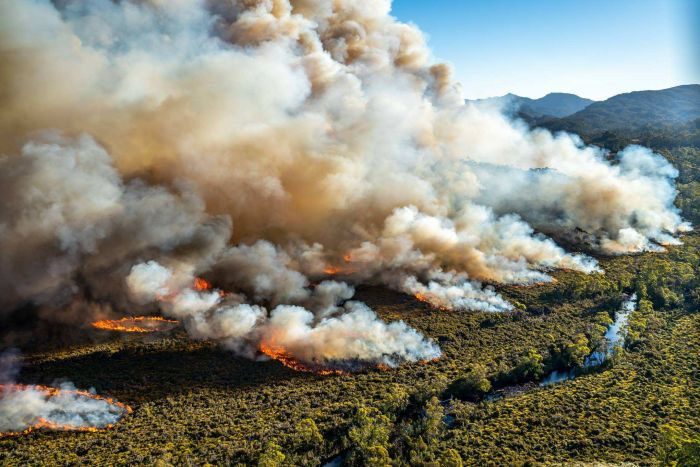This is our indefinite future as long as we fail to address climate change.

Of the many Tasmanian summers I remember, I cannot recall one quite like this.
Each of the main elements of this summer has happened many times before: blue haze from distant fires, smoke in the air, fiery suns, falling ash and embers, fire on the doorstep of the family home and smoke in city streets.
But this summer’s prolonged experiences – day after day of wood smoke permeating large parts of the island, of cloudless skies no longer blue, of red sunsets, of a lingering sense of foreboding hanging over multiple communities – add up to something new.
Some things stand out. The wisdom from past Tasmanian experiences was that devastating fire needs high winds in the north-western quarter. This summer shows that just dryness and relentless heat can do the job.
It was understood until recently that although odd fires are ignited by lighting strikes, humans are the main cause of wildfires. This year, nature has relegated humans to second place. Lightning storms without rain are now a significant ignition threat.
After a lightning fire devastated unique wilderness around Lake Mackenzie in 2016, a government-sponsored workshop concluded that preventing further such damage should be a primary goal.
If that was the aim this summer, it failed spectacularly. Despite heroic efforts to douse them, multiple fires sparked by dry lightning in late December and mid-January have damaged the Tasmanian wilderness on a scale that is rare if not unprecedented.
And long after the fires still threatening many communities are out, people will continue to feel the economic and psychological cost of the disruption they caused.
Tasmania’s hard-won reputation for clean air took a hit early on when smoke from the Gell River fires spread over Hobart. But if the sustained high level of smoke pollution in the south-east since mid-January is a sign of things to come, there are obvious health implications.
This very warm, very dry summer has exposed more than ever the vulnerability of both our wild places and our human communities to the ravages of fire. We have to do better.
This is in no way a criticism of Tasmania Fire Service, government and private land managers or the many paid and voluntary fire-fighters and supporters who have battled for weeks to keep the flames at bay. These organisations and people deserve our continuing gratitude and admiration.
Those charged with safeguarding settlements and natural values know the challenges and have done sterling work to prepare for wildfire attack, including holding community meetings and reducing fuel loads near residential areas.
They’re the first to agree much more remains to be done, but the means of making that happen are with the holders of the purse strings.
Premier Will Hodgman announced that disaster funding from Canberra, “certainly in the millions” will help meet public and community costs incurred by the fires. He added, I’m not sure why, that the money would not be used to rehabilitate burnt wilderness.
This is housekeeping, cleaning up after the event. It says nothing about how the government might address glaring gaps in our defences that allowed fires ignited by dry lightning to consume an area close to 200,000 hectares, most of it World Heritage property.
Meeting the challenge of future wildfire on this vegetation-rich island is a matter not just for this state but also for Canberra, which after all is responsible for the South-West World Heritage listing.
We have to continue improving our fire-fighting capacity. That demands people and other resources on the ground where they are needed to fight fires, but also to prepare ahead of time, which includes making permanent fire breaks near built-up areas and educating the public about wildfire.
Fire-fighting infrastructure will have to include purpose-designed water-bombing aircraft now routinely used in the US, but the high capital and running cost of this technology demands a national approach to funding and deployment. Melbourne is the logical base for such a resource.
Looming over all this is the elephant in the room, climate change. Australia’s problems with wildfire, coastal and river management, flooding and drought are seriously worsened by a hotter climate. We desperately need bipartisan federal and state action to meet that challenge.
This has to include steps to help Australians deal with and adapt to the above changes, and ultimately simply to survive in the kind of summer heat we can expect in future. Both Australia and Tasmania have just had their hottest January on record.
But summers will continue to get hotter as long as human carbon emissions keep rising. We can adapt all we like, but each year that we fail to mitigate will add more to the cost of adapting, ad infinitum.
The Hodgman and Morrison governments each claim to be meeting climate targets, but both have singularly failed in their clear obligation to bring emissions down. They owe it to us to get on their bikes and start pedalling – hard.
